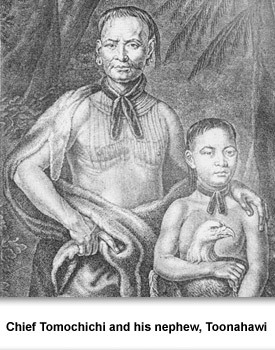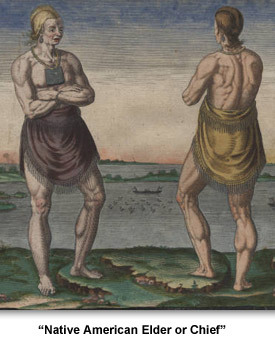Indians & Cultural Encounters
Who Was in Charge
There are not any native Indian documents that explain how 17th and 18th century American Indian politics worked. All we know is from European accounts which may not be accurate since the writer may not have understood how the system worked.
Europeans were amazed by what they saw as government in the tribes. Henry Timberlake wrote, “Their government, if I may call it government…has neither laws or power to support it” He went on to say it “is a mixed aristocracy and democracy.”
Europeans were also surprised to learn that Indian political leaders had no real power to make people obey them. Indians of all Southeastern tribes, except perhaps the Natchez, governed themselves by consensus, persuasion, and influence. There were no written laws.
Men and women led their people because they were able to convince others to follow them. The chiefs were not kings, who ruled by divine right, but leaders who spoke on behalf of the people. These leaders could be removed if they did not fulfill their duties and promises.
Even though there was less social rankings among the tribes of Tennessee than in European society, rank did exist and was jealously protected. Indians wore symbols of their achievements and wealth. The community punished people who claimed honors that they did not earn.
Picture Credits:
- Drawing entitled “Native American Elder or Chief.” The image is a double portrait showing two different views of a Native American elder wearing a cloth skirt and standing in front of the coast. Originally drawn by John Whyte this picture was included in the book A Briefe and True Report of the New Found Land of Virginia by Thomas Hariot. Later the image was engraved by Theodor de Bry and reprinted 1590. De Bry wanted to make Native Americans look more like Europeans, so he drew them with blonde hair and white skin. Although the drawing is not entirely accurate, it demonstrates how some Europeans did not understand or appreciate the ways in which Native Americans were different from them. The man pictured belongs to the Southern Algonquian group of Indians, who are related to the Shawnee. North Carolina Collection, University of North Carolina.
- Engraving of Chief Tomochichi and his nephew, Toonahawi in 1734 by Jon Faber, Jr. Tomochichi was a Creek leader and chief of the town of Yamacraw. He helped establish a peaceful relationship between the Creeks and English settlers. The Creek resided in northern Georgia but briefly occupied and visited areas in Tennessee. Negative 1129 A, Smithsonian Institution National Anthropological Archive.
Indians & Cultural Encounters >> Indian Life >> Who Was in Charge >>


 Sponsored by: National Endowment for the Humanities
Sponsored by: National Endowment for the Humanities